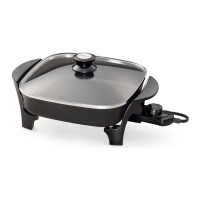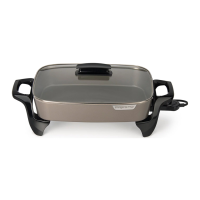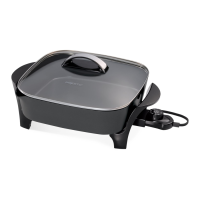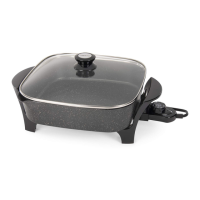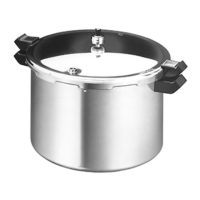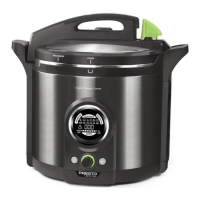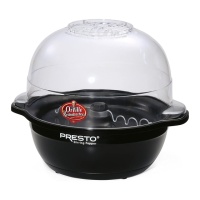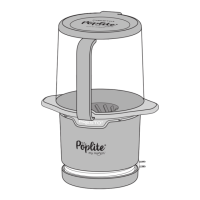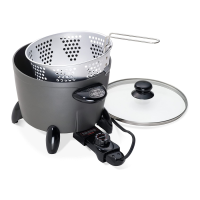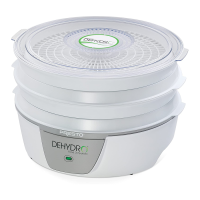4
• Dehydration prevents microbial growth; however, chemical reactions caused by enzymes in fruits and vegetables can occur unless
the food is pretreated before drying. Pretreatment will prevent or minimize undesirable color and texture changes during drying and
storage. See specific sections for recommended pretreatment.
• Place foods in a single layer on the trays. Do not allow food to touch or overlap.
• When drying strong-smelling foods, such as onions and garlic, be aware that there will be a strong odor during the drying process.
That odor may linger after drying has been completed.
• Individual pieces of food may not all dry at the same time. Foods that are appropriately dried should be removed before those that still
require additional drying. Always check all of the trays for foods that are appropriately dried. Allow dried pieces to cool and then
place in a covered container.
• If one tray of food is finished before the others, remove the dried food and return the empty tray to the unit rather than rearranging
the trays.
• Do not add fresh fruits and vegetables to a partially dried load. This will add moisture and increase the drying time.
• Allow for continuous drying. Do not unplug dehydrator in the middle of the drying cycle and resume drying at a later time as this may
result in poor quality and/or unsafe food.
• CAUTION! For food safety, wash hands thoroughly prior to preparing food for dehydrating. Likewise, thoroughly clean all utensils,
cutting boards, and counters that will be used for preparing food. Wash foods before preparing them for dehydrating.
How to Dehydrate Fruit and Fruit Rolls
Dried fruits and fruit rolls (or leathers) are nutritious and portable snacks. Drying fruit intensifies the natural sweetness of the fruit bcause
the moisture is removed.
Selection and Preparation
Select fruits that are at the peak of ripeness. Wash fruits to remove dirt and debris. There are many options when it comes to drying fruit
and personal preference should be your guide. Fruits can be sliced, halved, or left whole (if small); peeled or unpeeled; pretreated or left
untreated. Fruits that are sliced thin and peeled will dry the fastest. Fruits left whole will require the most drying time.
Slice fruit uniformly and in pieces about ¼ inch thick. Fruits that are left whole, such as blueberries, cranberries, and grapes, should be
dipped in boiling water for 30 to 60 seconds and then plunged in ice water to crack the skin. This procedure will reduce the drying time.
Pretreatment
Many fruits will darken quickly once they are peeled and/or cut and will continue to darken even after the fruit is dried. This is due to the
exposure of the natural enzymes in some fruits to air. There are several pretreatment options to prevent this discoloration. Pretreatment
is not necessary but is recommended to preserve color and texture of the dried fruit. Some people may detect a slight flavor change with
pretreated fruit. See the Fruit Drying Guide on page 6 to determine which fruits will benefit from pretreatment. You may want to try the
different options and see which you prefer.
Ascorbic acid (Vitamin C)—Ascorbic acid, available in tablet or powdered form, is available at drugstores. Mix 2½ tablespoons
of powdered ascorbic acid in 1 quart cold water. Vitamin C tablets (six 500 mg tablets equal 1 teaspoon ascorbic acid) should be
crushed before mixing with water. Place cut fruit, such as bananas, peaches, apples, or pears, in mixture and soak for 10 minutes.
Remove fruit and drain well before placing on drying trays.
Ascorbic acid mixtures—These commercially available products, such as Mrs. Wages Fresh Fruit Preserver,* are a combination of
ascorbic acid and sugar and are commonly used for fresh fruits and for canning and freezing. Follow the manufacturers’ directions
for use of these mixtures.
Lemon juice—Mix equal parts lemon juice and cold water. Place cut fruit in solution and soak for 10 minutes. Remove fruit and
drain well before placing on drying trays.
Place pieces of fruit on dehydrator trays in a single layer, close together but not touching or overlapping. Refer to the Fruit Drying Guide
on page 6 for suggested preparation, pretreatment, and drying times. Dry fruit at 135°F (57°C).
WARNING! Do not spill or allow liquid, including marinade, to drip into the base of the unit as it may damage the product. The center
hub screen on the base platform must never be obstructed. If liquid or grease drip onto the screen, unplug the unit and remove the
screen to clean it. Replace the screen and operate without trays for 30 minutes while monitoring the unit to ensure it is functioning
properly and is not smoking. If the unit operates properly, continue dehydrating per the instructions. If the unit smokes, unplug it
immediately and discontinue use.
* Mrs. Wages is a registered trademark of Kent Precision Foods Group, Inc. Presto is not affiliated with this company.
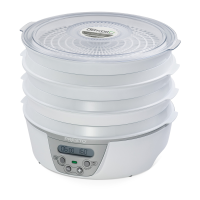
